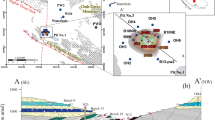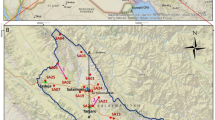Abstract
Major ion geochemistry and environmental isotopes were used to identify the origins and the mineralisation processes of groundwater flowing within the three aquifer levels of the multilayer system of the Gafsa-south mining district (Southwestern Tunisia). It has been demonstrated that groundwaters are characterised by a Ca–Mg–SO4 water type. Geochemical pattern is mainly controlled by the dissolution of halite, gypsum and/or anhydrite as well as by the incongruent dissolution of dolomite. δ18O and δ2H values are much lower than the isotopic signature of regional precipitation and fall close to the meteoric water lines, indicating that groundwaters have not been significantly affected by evaporation or mineral–water reactions. The distribution of stable and radiogenic isotopes (δ18O, δ2H, δ13C and 14C) within the aquifer levels suggests that the deep confined aquifer receives a significant modern recharge at higher altitudes, while, the shallow unconfined aquifer has been mainly recharged under cooler paleoclimatic condition, likely during Late Pleistocene and Early Holocene humid periods. However, waters from the intermediate confined/unconfined aquifer have composite isotopic signatures, highlighting that they are derived from a mixture of the two first end-members.











Similar content being viewed by others
References
Ahmadi R (2006) Utilisation des marqueurs morphologiques, sédimentologiques et microstructuraux pour la validation des modèles cinématiques de plissement. Application à l’Atlas méridional tunisien. Ph.D. Thesis, University of Nantes, France, pp 200
Ahmadi R, Ouali J, Mercier E, Van-Vliet Lanöe B, Mansy JL, Rekhiss F (2006) The geomorphologic hallmarks of hinge migration in the Fault related folds: a study case in Southern Tunisian Atlas. J Struct Geol 28:721–728
Allison GB (1982) The relationship between 18O and deuterium in water and in sand columns undergoing evaporation. J Hydrol 76:1–25
APHA (1998) Standard methods for the examination of water and wastewater, 20th edn. APHA-AWWA-WET, Washington, DC
Banner JL, Wasserburg GJ, Dobson PF, Carpenter AB, Moore CH (1989) Isotopic and trace-element constraints on the origin and evolution of saline groundwaters from central Missouri. Geochim Cosmochim Acta 53:383–398
Barth SR (2000) Stable isotope geochemistry of sediment-hosted groundwater from a Late Paleozoic–Early Mesozoic section in central Europe. J Hydrol 235:72–87
Ben Moussa A, Zouari K, Oueslati N (2009) Geochemical study of groundwater mineralization in the Grombalia shallow aquifer, north-eastern Tunisia: implication of irrigation and industrial waste water accounting. Environ Geol 58:555–567
Boaretto E, Thorling L, Sveinbjornsdottir AE, Yechieli Y, Heinemeier J (1998) Study of the effect of fossil organic carbon on 14C in groundwater from Hvinningdal, Denmark. Radiocarbon 40:915–920
Boujlel B, Hamed H, Slimene F, Ben Ali R, Belhammami K, Hamed Y, Ben Dhia H (2008) Evolution of research activities of Gafsa phosphate company. In: 22nd Colloquim of African Geology and 13th conference of Geological Society of Africa Hammamet, Tunisia, 2008, pp 4–6
Burollet PF (1956) Contribution à l’étude stratigraphique de la Tunisie Centrale. Ann Mines Geol 18:345
Chadha DK (1999) A new diagram for geochemical classification of natural waters and interpretation of chemical data. Hydrogeol J 7:431–439
Chaieb M, Boukhriss M (1998) Flore suscinte et illustrée des zones arides et sahariennes de Tunisie. APNES, Tunis, p 29
Clark ID, Fritz P (1997) Environmental isotopes in hydrogeology. Lewis Publishers, New York, p 328
Coleman ML, Shepherd TJ, Durham JJ, Rouse JE, Moore GR (1982) Reduction of water with zinc for hydrogen isotope analysis. Anal Chem 54:993–995
CPG-GCT (2009) Tunisian phosphate industry. Accessible at: http://www.gct.com.tn/francais/secteur.htm
Craig H (1961) Isotopic variations in meteoric water. Science 133:1702–1703
Dassi L, Zouari K, Faye S (2004) Identifying sources of groundwater recharge in the Merguellil basin (Tunisia) using isotopic methods: implication of dam reservoir water accounting. Environ Geol 49:114–123
Dassi L, Zouari K, Seiler KP, Faye S, Kamel S (2005) Flow exchange between the deep and shallow groundwaters in the Sbeïtla synclinal basin (Tunisia): an isotopic approach. Environ Geol 47:501–511
Deines P (1980) The terrestrial environment. In: Fritz P, Fontes JC (eds) Handbook of environmental isotope geochemistry, vol 1. Elsevier, Amsterdam, pp 75–140
DGRE (Direction Générale des Ressources en Eau) (2009) Annuaire de l’exploitation des nappes profondes de la Tunisie. DGRE, Tunis
Dlala M, Hfaiedh M (1993) Le séisme du 7 Novembre 1989 à Metlaoui (Tunisie Méridionale): une tectonique active en compression. C R Acad Sci 317:1297–1307
Durov SA (1948) Natural waters and graphic representation of their compositions. Dokl Akad Nauk SSSR 59:87–90
Edmunds WM (2005) Contribution of isotopic and nuclear tracers to study of groundwater. In: Aggarwal PK, Gat JR, Froehlich KFO (eds) Isotopes in the water cycle: past, present and future of a developing science. IAEA, Springer, Netherlands, p 381
Edmunds WM, Smedley PL (2000) Residence time indicators in groundwater: the East Midlands Triassic sandstone aquifer. Appl Geochem 15:737–752
Edmunds WM, Shand P, Guendouz AH, Moula A, Mamou A, Zouari K (1997) Recharge characteristics and groundwater quality of the grand erg oriental basin. Technical report Wd/97/46R, Vienna
Edmunds WM, Guendouz AH, Mamou A, Moula A, Shand P, Zouari K (2003) Groundwater evolution in the Continental Intercalaire aquifer of southern Algeria and Tunisia: trace element and isotopic indicators. Appl Geochem 18:805–822
Epstein S, Meyada TK (1953) Variations of 18O content of waters from natural sources. Geochim Cosmochim Acta 4:213–224
Faure G (1986) Principles of isotope geology. Wiley, New York, p 589
Fontes JCH (1985) Some considerations on ground water dating using environmental isotopes hydrogeology in the service of man, Memories of the 18th Congress of the International association of Hydrogeologists, Cambridge
Fontes JC, Coque R, Dever L, Filly A, Mamou A (1983) Palèohydrologie isotopique de l’wadi el Akarit (sud tunisien) au Plèistocène et a` l’Holocène. Pal Pal Pal 43:41–61
Fritz P, Clark ID, Fontes JC, Whiticar MJ, Faber E (1992) Deuterium and 13C evidence for low temperature production of hydrogen and methane in a highly alkaline groundwater environment on Oman. In: Kharaka Y, Maest AS (eds) Proceedings of the 7th international symposium on water–rock interaction. Balkema, Park City, pp 793–796
Gat JR (1981) Groundwater. In: Gat JR, Gonfiantini R (eds) Stable isotope hydrology, Set IAEA, Vienna. Technical report, Set 210, p 226
Gonfiantini R, Conrad G, Fontes JC, Sauzay G, Payne BR (1974) Etude isotopique de la nappe du continental intercalaire et de ses relations avec les autres nappes du Sahara septentrional. In: Proceedings of IAEA symposium on isotope techniques in groundwater hydrology, Vienna, 1974, pp 227–241
Grabczak J, Kotarba M (1985) Isotope composition of thermal waters in the central part of the Nepal Himalaya. Geothermics 14(4):567–575
Grassi S, Cortecci G (2005) Hydrogeology and geochemistry of the multilayered confined aquifer of the Pisa plain (Tuscany-Central Italy). Appl Geochem 20:41–54
Guendouz A, Moulla AS, Edmunds WM, Zouari K, Shand P, Mamou A (2003) Hydrogeochemical and isotopic evolution of water in the Complex Terminal aquifer in the Algerian Sahara. J Hydrol 11:483–495
Hamed Y (2008) Caractérisation hydrogéologique, hydrochimique et isotopique du système aquifère de Moularès-Tamerza. Ph.D. Thesis, University of Sfax, pp 280
Hamed Y, Dassi L, Ahmadi R, Ben Dhia H (2008) Geochemical and isotopic study of the multilayer aquifer system in the Moulares-Redayef basin, southern Tunisia. Hydrol Sci J 53(5):1241–1252
Hanshaw BB, Back W (1979) Major geochemical processes in the evolution of carbonate aquifer systems. J Hydrol 43:287–312
IAEA/WMO (1999) Global Network of Isotopes in Precipitation. The GNIP Database, Station 7622500. Accessible at: http://isohis.iaea.org
Kamel S, Dassi L, Zouari K, Abidi B (2005) Geochemical and isotopic investigation of the aquifer system in the Djerid-Nefzaoua basin, southern Tunisia. Environ Geol 49:159–170
Kamel S, Dassi L, Zouari K (2006) Approche hydrogéologique et hydrochimique des échanges hydrodynamiques entre aquifères profond et superficiel du bassin du Djérid, Tunisie. Hydrol Sci J 51(4):713–730
Leybourne MI, Clark ID, Goodfellow WD (2006) Stable isotope geochemistry of ground and surface waters associated with undisturbed massive sulfide deposits; constraints on origin of waters and water–rock reactions. Chem Geol 231:300–325
Maliki MA (2000) Etude hydrogéologique, hydrochimique et isotopique de système aquifère de Sfax (Tunisie). Ph.D. Thesis, University of Tunis II
Maliki MA, Krimissa M, Michelot JL, Zouari K (2000) Relation entre nappes superficielles et aquifère profond dans le bassin de Sfax (Tunisie). CR Acad Sci Rev 331:1–6
Marfiaa AM, Krishnamurthya RV, Atekwanab EA, Pantonc WF (2004) Isotopic and geochemical evolution of ground and surface waters in a karst dominated geological setting a case study from Belize Central America. Appl Geochem 19:937–946
McIntosh JC, Walter LM (2006) Paleowaters in Silurian–Devonian carbonate aquifers: geochemical evolution of groundwater in the Great Lakes region since the Late Pleistocene. Geochim Cosmochim Acta 70:2454–2479
Naeili MS, Boujlel B, Hajji Y, Ouled Ghrib A, Bouzaeine A, Hamed H, Hamed Y and Ben Dhia H (2008) La compagnie des phosphates de Gafsa plus d’un siècle de développement dans son environnement socio-économique. In: 22nd Colloquim of African Geology and 13th conference of Geological Society of Africa Hammamet Tunisia, 4–6 November
Ouattani F, Addoum B, Mercier E, Frizon De Lamotte D, Andrieux J (1995) Geometry and kinematics of the south Atlas front, Algeria and Tunisia. Tectonophysics 249:233–248
Piper AM (1944) A graphic procedure in the geochemical interpretation of water-analyses. Trans Am Geophys Union 25:914–923
Romanek CS, Grossman EL, Morse JW (1992) Carbon isotopes fractionation in synthetic aragonite and calcite: effects of temperature and precipitation rate. Geochim Cosmochim Acta 56:419–430
Sacks LA, Tihansky AB (1996) Geochemical and isotopic composition of groundwater with emphasis on sources of sulphates, in the Upper Floridian aquifer and intermediate aquifer system in southwest Florida. US Geological Survey Water-Resources Investigations report, pp 67
Shouakar-Stash O, Alexeev SV, Frape SK, Alexeeva LP, Drimmie RJ (2007) Geochemistry and stable isotopic signatures, including chlorine and bromine isotopes, of the deep groundwaters of the Siberian Platform, Russia. Appl Geochem 22:589–605
Sonntag C, Klitzsch E, Lohnert EP, El-Shazly EM, Mijnnich KC, Junghans C, Thorweihe U, Weitroffer K, Swailem FM (1978) Paleoclimatic information from deuterium and oxygen-18 in Carbon-14-dated north Saharian groundwaters. In: isotope hydrology, vol II, IAEA-SM-228, (28), pp 569–581
Stuiver M, Polach HA (1977) Discussion reporting of 14C data. Radicarbon 19:355–363
Thomas PE (1893) Exploration scientifique de la Tunisie. Illustrations de quelques fossiles nouveaux ou critiques des terrains tertiaires et secondaires de la Tunisie, recueillis en 1885 et 1886 par Philippe Thomas. Imprimerie Nationale, Paris
Traganos G, Jux U, Steuber T (1995) Isotopic characteristics of geothermal waters and fossil spring deposits in Mygdonia basin, northern Greece. Geothermics 24(1):61–80
Uliana MM, Banner JL, Sharp JJM (2007) Regional groundwater flow paths in Trans-Pecos, Texas inferred from oxygen, hydrogen, and strontium isotopes. J Hydrol 334:334–346
Vogel JC (1993) Variability of carbon isotope fractionation during photosynthesis. In: Ehleringer JR, Hall AE, Farquhar GD (eds) Stable isotopes and plant carbon–water relations. Academic Press, San Diego, pp 29–46
Zargouni F (1985) Tectonique de l’Atlas Méridional de Tunisie : evolution géométrique et cinématique des structures en zone de cisaillement. Rev Sci Terre 3:304
Zouari H (1995) Evolution géodynamique de l’Atlas centro-méridional de la Tunisie: stratigraphie, analyses géométrique, cinématique et tectono-sédimentaire. Thèse de Doctorat d’Etat, Université de Tunis II
Author information
Authors and Affiliations
Corresponding author
Rights and permissions
About this article
Cite this article
Hamed, Y., Dassi, L., Tarki, M. et al. Groundwater origins and mixing pattern in the multilayer aquifer system of the Gafsa-south mining district: a chemical and isotopic approach. Environ Earth Sci 63, 1355–1368 (2011). https://doi.org/10.1007/s12665-010-0806-x
Received:
Accepted:
Published:
Issue Date:
DOI: https://doi.org/10.1007/s12665-010-0806-x




